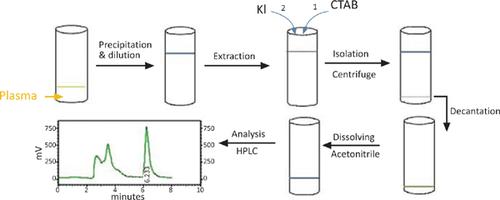Current Analytical Chemistry ( IF 1.7 ) Pub Date : 2020-08-31 , DOI: 10.2174/1573411015666190617105034 Azam Samadi 1 , Abolghasem Jouyban 1 , Negar Amirhaghiian 2 , Hamid Tayebi-Khosroshahi 3

|
Background: Uremia is the outcome of the remaining of nitrogenous waste products that are normally removed by the kidneys. Para-cresol (4-methylphenol) can be regarded as a proteinbound uremic toxin. The p-cresol determination in sera is necessary since it is a marker of cardiovascular risk and overall mortality in hemodialysis patients. Among the reported methods, chromatographic ones especially HPLC techniques due to the high sensitivity, selectivity and reproducibility have been extensively exploited in analysis of p-cresol in complex mixtures. However, an appropriate sample preparation prior to analysis is necessary for obtaining accurate and precise results.
Methods: In this study, the appropriate precipitating agent for p-cresol determination in plasma samples was investigated. Then, in situ surfactant-based solid phase microextraction followed by HPLCFL detection was developed and validated for the quantification of p-cresol in plasma samples.
Results: According to the results, HCl/heat precipitation method was used for p-cresol microextraction from from plasma samples. In situ surfactant-based solid phase microextraction using cetyltrimethylammonium bromide as extraction medium was proposed for pretreatment of plasma samples prior to analysis. The separation was achieved by isocratic elution with sodium acetate buffer (pH 3.8) and acetonitrile (20:80, v/v). Linearity was found to be acceptable over the concentration ranges of 0.5 to 8 μg mL-1 with the limit of detection and quantification of 0.324 and 0.422 μg mL-1, respectively. The variations for intra-day and inter-day precisions were both less than 8.2% and the extraction recoveries were more than 97%.
Conclusion: A validated ISS-SPME followed by HPLC-FL detection reported to determine the total p-cresol concentration of human plasma samples. The traditional liquid-liquid extraction techniques are normally time consuming and require the use of large amounts of toxic organic solvents. In addition, the evaporation of extraction solvent and dissolving the analyte in the mobile phase is commonly used before HPLC analysis. Such a requirement makes the sample preparation process even more tedious and time consuming. ISS-SPME that is the developed ISS-SPE in micro scale, is a simple, rapid and effective sample preparation technique that is appropriate for HPLC-FL analysis.
中文翻译:

HPLC分析前在人血浆中对甲酚进行基于表面活性剂的固相微萃取
背景:尿毒症是通常由肾脏清除的含氮废物的残留物。对甲酚(4-甲基苯酚)可以被认为是蛋白结合的尿毒症毒素。血清中对甲酚的测定是必要的,因为它是血液透析患者心血管风险和整体死亡率的标志。在所报道的方法中,由于具有高灵敏度,选择性和重现性的色谱方法,尤其是HPLC技术,已被广泛用于分析复杂混合物中的对甲酚。但是,为了获得准确和精确的结果,必须在分析之前进行适当的样品制备。
方法:在这项研究中,研究了用于血浆样品中对甲酚测定的合适沉淀剂。然后,开发了基于表面活性剂的原位固相微萃取,然后进行HPLCFL检测,并进行了血浆样品中对甲酚定量的验证。
结果:根据结果,使用盐酸/热沉淀法从血浆样品中对对甲酚微萃取。在分析之前,建议使用十六烷基三甲基溴化铵作为提取介质的基于表面活性剂的固相微萃取技术对血浆样品进行预处理。通过用乙酸钠缓冲液(pH 3.8)和乙腈(20:80,v / v)等度洗脱实现分离。发现线性在0.5至8μgmL-1的浓度范围内均可接受,检测和定量限分别为0.324和0.422μgmL-1。日内和日间精度的变化均小于8.2%,提取回收率大于97%。
结论:据报道,经过验证的ISS-SPME和HPLC-FL检测可确定人血浆样品的总对甲酚浓度。传统的液-液萃取技术通常很耗时,并且需要使用大量有毒的有机溶剂。此外,在进行HPLC分析之前,通常会使用萃取溶剂的蒸发并将分析物溶解在流动相中。这样的要求使得样品制备过程更加繁琐且耗时。ISS-SPME是微尺度开发的ISS-SPE,是一种简单,快速且有效的样品制备技术,适用于HPLC-FL分析。











































 京公网安备 11010802027423号
京公网安备 11010802027423号